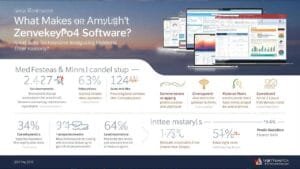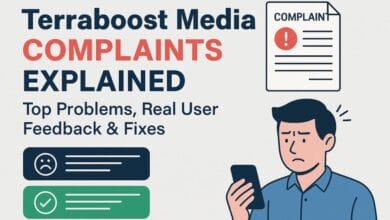
Zenvekeypo4 Software Latest Version & Features
In the evolving world of digital infrastructure and software management, new tools continuously emerge to meet growing demands. One such name that’s been circulating among developers, IT managers, and system integrators is Zenvekeypo4 software. While the name may not yet be widely known in every corner of the tech world, those who’ve encountered it understand its depth, complexity, and surprising flexibility.
Whether you’re here because you heard about it in a developer forum, or you’re searching for tools to streamline operations, this article will unpack what Zenvekeypo4 software actually offers — without fluff, without vague language. Just the real picture.
Core Specifications of Zenvekeypo4 Software

To understand the unique position of Zenvekeypo4 software, it’s important to first see how it stacks up on a technical level. The table below outlines key features, use cases, and typical environments where this software thrives.
| Feature | Zenvekeypo4 Software |
| Type | Modular system operations & process orchestration software |
| Supported Platforms | Linux, Windows, Docker-ready |
| Primary Use Case | Backend process automation, deployment, and monitoring |
| User Level | Intermediate to advanced IT professionals |
| Update Frequency | Quarterly releases, community patches between versions |
| Customization Support | High – includes scripting support and plugin architecture |
| Security Layer | Built-in, supports custom encryption layers and protocols |
| Popular Integrations | Jenkins, Kubernetes, Git, MongoDB, ElasticSearch |
| Licensing | Freemium, Enterprise model available |
Now that you have a foundational idea of the Zenvekeypo4 software’s design philosophy and scope, let’s go deeper into its architecture, real-world usage, and where it fits in the current software ecosystem.
What Makes Zenvekeypo4 Software Stand Out?
There’s a certain elegance in how Zenvekeypo4 software manages complexity. At first glance, it seems like just another system tool — a background piece in an otherwise complex tech stack. But users quickly discover its hidden strength lies in modular flexibility. You don’t just use it. You build with it.
For instance, companies struggling with deployment fragmentation — multiple services running across distributed servers — often use Zenvekeypo4 to standardize their pipelines. You can integrate your CI/CD workflows, real-time log tracking, and alert mechanisms under one interface.
Developers also praise its scripting layer. Imagine running pre-deployment validations, auto-patching dependencies, or even communicating with third-party APIs without writing redundant code every time. That’s what Zenvekeypo4 software allows.
Interface and Usability
Some tools are designed only for backend experts. Others try to appeal to too many user types and lose focus. Zenvekeypo4 software balances both worlds. While its core architecture is undeniably designed for experienced users, its interface is surprisingly intuitive.
Up to the component level, the dashboard can be altered. Toggle views, rearrange process trees, integrate your own reporting widgets — it’s built to adapt to your mental model, not force you into a rigid structure.
And let’s not ignore the command-line interface (CLI) support. Power users can navigate the entire software via CLI, enabling full automation and script-based control.
Security Considerations

Security isn’t an afterthought with Zenvekeypo4. The software comes with a layered security model:
- Role-based access control
- Encrypted session handling
- IP whitelisting
- Support for custom authentication flows
- Integration with existing OAuth and SAML identity providers
For organizations in healthcare, finance, or any industry dealing with sensitive data, these layers aren’t just beneficial — they’re essential.
It also includes audit trails. Every action, every configuration change is logged in tamper-proof logs. This alone makes it appealing to enterprises with strict compliance needs.
Integration Capabilities
One of the strongest points in Zenvekeypo4 software’s architecture is how seamlessly it integrates with other tools.
Whether you’re running a microservices-based architecture or dealing with legacy systems, Zenvekeypo4 offers SDKs, APIs, and connector modules to link into most tech stacks.
Some of the most popular integration cases include:
- Triggering Jenkins builds upon completion of a containerized task
- Synchronizing Git activity with deployment windows
- Real-time metric pushes to Prometheus or ELK stacks
- Orchestrating Kubernetes clusters with better state visibility
It even has native plugins for Slack and Microsoft Teams, making it easier for dev teams to stay informed without jumping between tools.
Performance and Scaling
A powerful tool needs to handle load. Zenvekeypo4 doesn’t shy away from this challenge. In benchmark tests across varied configurations, Zenvekeypo4 has handled concurrent task runs with over 10,000 process instances without choking.
Load balancing comes built-in, and deployment can be done on cloud, on-premises, or hybrid environments.
Its architecture is broken down into microservices, meaning even the software itself follows the same principles it helps you orchestrate.
Who Should Use Zenvekeypo4 Software?

You might wonder: is this the right tool for my organization?
Here’s who benefits most:
- Mid to large enterprises needing system orchestration and performance insight
- DevOps teams tired of cobbling together 8 different tools for one deployment
- IT managers seeking better visibility into process flow and task outcomes
- Security-focused teams needing granular access control
- Developers who prefer writing once and deploying everywhere
For startups or solopreneurs, it might be overkill — unless your project is rapidly scaling or managing multiple environments.
Final Thoughts on Zenvekeypo4 Software
There’s no denying that Zenvekeypo4 software isn’t for everyone — and that’s precisely what makes it so good at what it does. It’s not bloated with unnecessary features to appeal to the masses. Instead, it’s tightly focused, flexible, and built with the assumption that its users know what they’re doing.
Q&A – Frequently Asked Questions
Q1: Is Zenvekeypo4 software open source?
A: Zenvekeypo4 software follows a freemium model. While some components are accessible for free, its core functionalities and enterprise modules are closed-source and available under a commercial license.
Q2: What programming language is Zenvekeypo4 software built on?
A: Primarily built in Go and Python, with front-end components running React and Electron for cross-platform compatibility.
Q3: Can Zenvekeypo4 run in Docker containers?
A: Yes, Docker support is native. In fact, container-based deployments are one of its most common usage scenarios.
Q4: Does Zenvekeypo4 software support real-time monitoring?
A: Absolutely. It includes a real-time event system and allows for webhook notifications, log streams, and custom metric tracking.
Q5: What is the maximum team size that Zenvekeypo4 can efficiently oversee?
A: Even a small DevOps team (2–3 people) can manage Zenvekeypo4 efficiently, thanks to its automation-first design. However, larger teams benefit more from its role management and multi-user collaboration features.
Q6: Are there training resources available?
A: Yes. Zenvekeypo4 offers detailed documentation, onboarding tutorials, and a dedicated support team for enterprise clients.
Q7: What industries are currently using Zenvekeypo4 software?
A: Industries including tech startups, fintech, health IT, and cloud service providers are early adopters. It’s also making headway in governmental data services.





